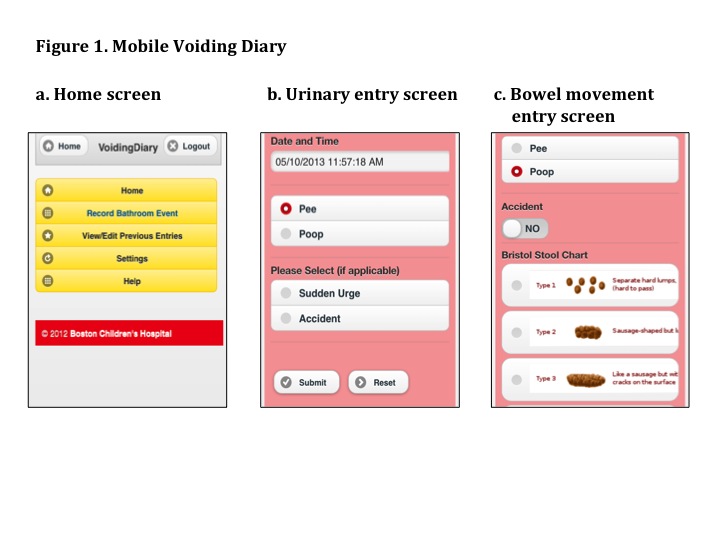|
Back to Fall Congress
Evaluation of a mobile voiding diary for pediatric patients with voiding dysfunction: A prospective comparative study
Emilie K. Johnson, MD, MPH, Carlos A. Estrada, MD, Kathryn L. Johnson, BA, Hiep T. Nguyen, MD, Ilina Rosoklija, MPH, Caleb P. Nelson, MD, MPH.
Boston Children's Hospital, Boston, MA, USA.
BACKGROUND: Voiding diaries (VDs) are commonly used for evaluating children with voiding dysfunction. Anecdotally, compliance with filling out VDs is variable, as is data quality for those that are completed. One potential strategy for improving completion rates and data quality of VDs is the use of a mobile, electronic format. The aims of our study were to (1) develop a mobile VD software application; (2) evaluate the acceptability and feasibility of the mobile VD for patients with non-neurogenic voiding dysfunction and (3) to compare the mobile format with the standard paper VD.
METHODS: In conjunction with software developers at our institution, we designed a mobile VD webapp for recording urinary and bowel habits (Figure 1). We then prospectively enrolled pediatric patients presenting for an initial visit for daytime voiding symptoms from 7/2012-4/2013. Using a pre/post design, we enrolled an initial cohort of patients who were provided a standard paper VD prior to clinic, and a subsequent cohort who were provided a link to the mobile webapp. We conducted in-person interviews and assessed VD completion, quality, and patient/parent attitudes towards the diary. Completion rates and data quality measures were compared between patients receiving paper vs. mobile VDs. We also assessed the acceptability of a hypothetical mobile VD for those patients receiving a paper VD.
RESULTS: We enrolled 45 patients (median age 6.5 years, 68% female) who received a paper VD, and 38 patients (median age 7 years, 69% female) who received the mobile version. Completion rates were 78% for paper VDs, and 61% for mobile VDs (p=0.10). Data quality measures for patients completing paper VDs (vs. mobile) demonstrated: a higher proportion of patients filling out a full 5 days of data (63% paper vs. 52% mobile) and a lower proportion with gaps in their data (20% paper vs. 65% mobile). However, the paper VD also showed a lower proportion that were completely legible (80% paper vs. 100% mobile), and a lower proportion where all data was entered prospectively (40% paper vs. 65% mobile). Families completing mobile VD provided our team with concrete technical suggestions that allowed iterative improvement of our design. Although completion rates were lower for the mobile diary, multiple families who were provided the paper diary mentioned a mobile option as a general suggestion for improvement, and 87% were interested in a mobile/electronic VD option when directly queried.
CONCLUSIONS: The development and use of a mobile VD was acceptable and feasible for our population of patients with voiding dysfunction, although completion rates were somewhat lower for mobile VDs. Data quality was not clearly better for either version. Patient feedback was integral in the development of updated versions of our mobile VD. The mobile VD format may offer data quality advantages for select groups, but did not demonstrate significant superiority when provided to all patients in our clinic with access to a smartphone.

Back to Fall Congress
|


